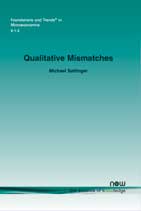Qualitative Mismatches
By Michael Sattinger, Department of Economics, University at Albany, USA, m.sattinger@albany.edu
Abstract
Qualitative mismatches arise when the qualifications or skills of workers, individually or in the aggregate, are different from the qualifications or skills required or specified for their jobs. This review provides an introduction to the subject as well as a survey for social scientists conducting research on incidence, causes and consequences of qualitative mismatches. The review distinguishes between short run mismatches occurring between workers and jobs and long run aggregate mismatches that arise from shifts in supplies and demands for workers. Incidence of qualitative mismatches is related to regression toward the mean and wage consequences are explained by assignment models with Nash bargaining, among other theories. The review considers explanations of current long run qualitative mismatches provided by Goldin and Katz as well as others, and describes the differences between the U.S. and other countries in the evolution of the imbalance. A primary source for the difference in outcomes is that private costs of higher education are significantly higher in the U.S. The review considers policy implications of qualitative mismatches and contrasts educational approaches in the U.S. and European countries. Open questions in qualitative mismatches are considered including the determinants of wage consequences, how qualitative mismatches change with the business cycle, the relevance of qualitative mismatches for search and matching models of the aggregate labor market, the reduced supply response of higher education in the U.S. in spite of greater educational differentials, causes of increasing inequality, and optimal policies in the short and long run to reduce qualitative mismatches.
Qualitative Mismatches
Qualitative Mismatches develops the distinction between short run qualitative mismatches for individual workers and employers and long run aggregate qualitative mismatches arising from changes in the quantity demanded or supplied in a category of the labor market. Without the distinction between the two forms, a measurement of one could be mistaken for the other. The methods and data used to examine the two forms of qualitative mismatches also differ. Short run qualitative mismatches arise as a consequence of extensive job and worker variety combined with imperfect information and frictions in the labor market that require workers and employers to engage in search to establish employment. Short run qualitative mismatches are studied by examining how the labor market assigns workers to jobs through search by workers and employers, and how qualitative mismatches arise as a consequence of the strategies of workers and employers in the presence of costly search. In contrast, long run aggregate qualitative mismatches arise when the economy changes in a way that alters the mix of job characteristics, or the incentives for individuals to obtain education and training change in a way that alters the mix of worker characteristics. Long run qualitative mismatches are studied by examining the consequences of trends in economies and societies that generate shifts in demands and supplies, including technology, globalization, organization of work, and educational institutions. Qualitative Mismatches explains that mismatches at a point in time can be regarded as arising from three sources. First, there is a level that arises from the search procedures that workers use to find jobs and employers use to find workers. Second, there is a level of mismatch that arises over the course of a business cycle as a result of workers with high education and skill levels taking jobs at which they are overqualified during high unemployment, or firms hiring workers that do not meet their requirements during low unemployment. Third, there are additional mismatches that could arise if there are imbalances between supplies and demands from long run aggregate qualitative mismatches. It is possible that over-qualification at one level could cancel out some under-qualification at another level, so that the three levels are not simply added together.
